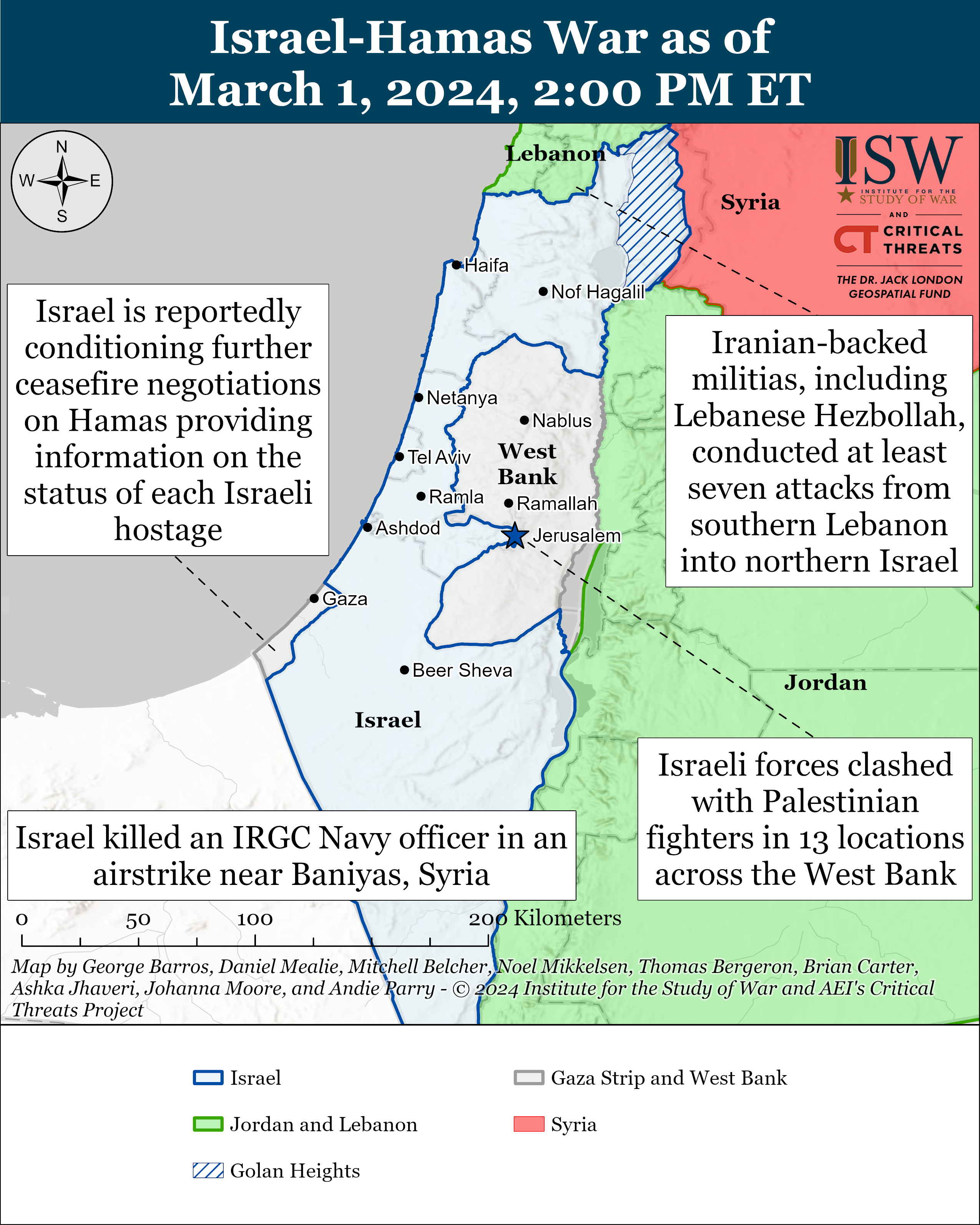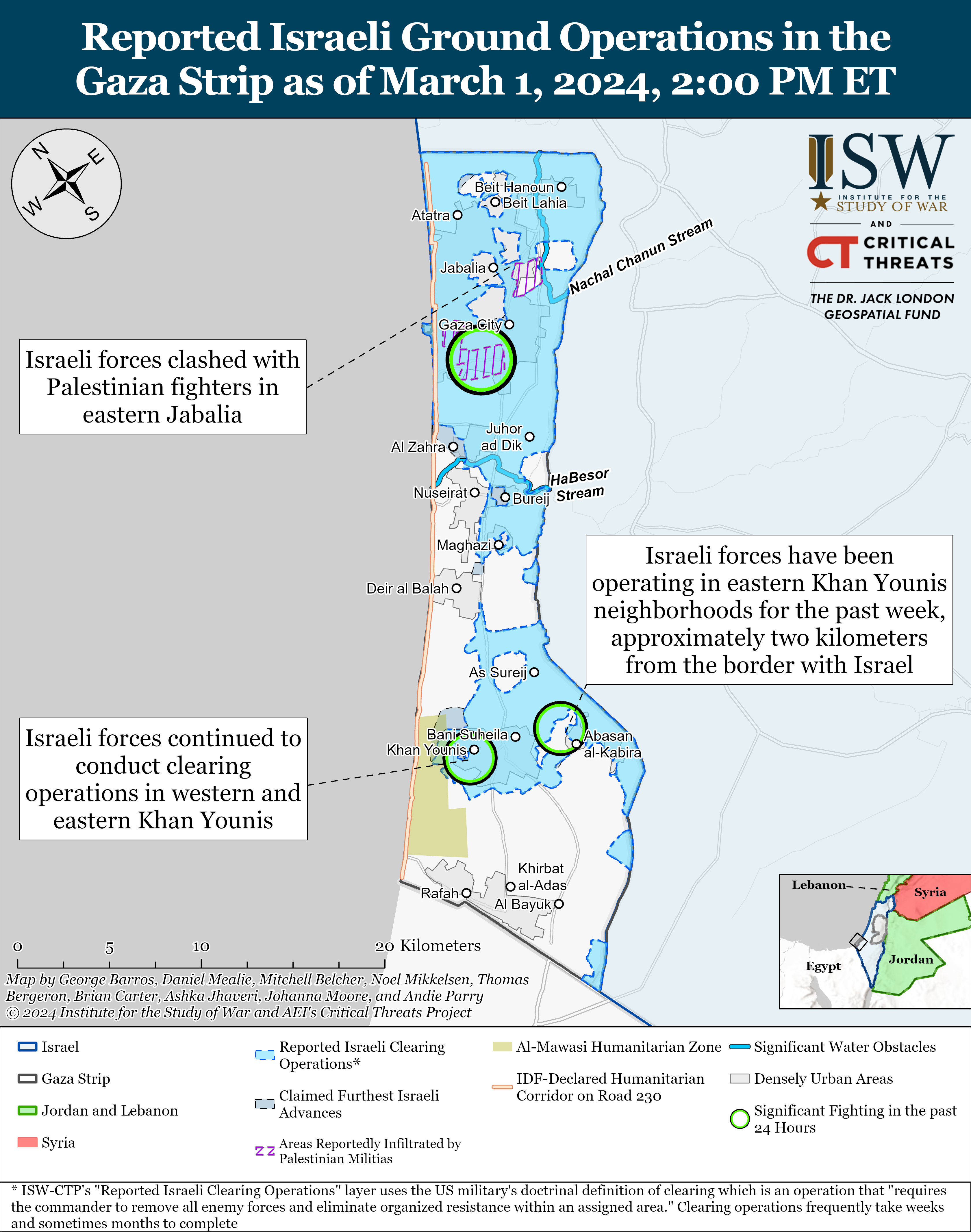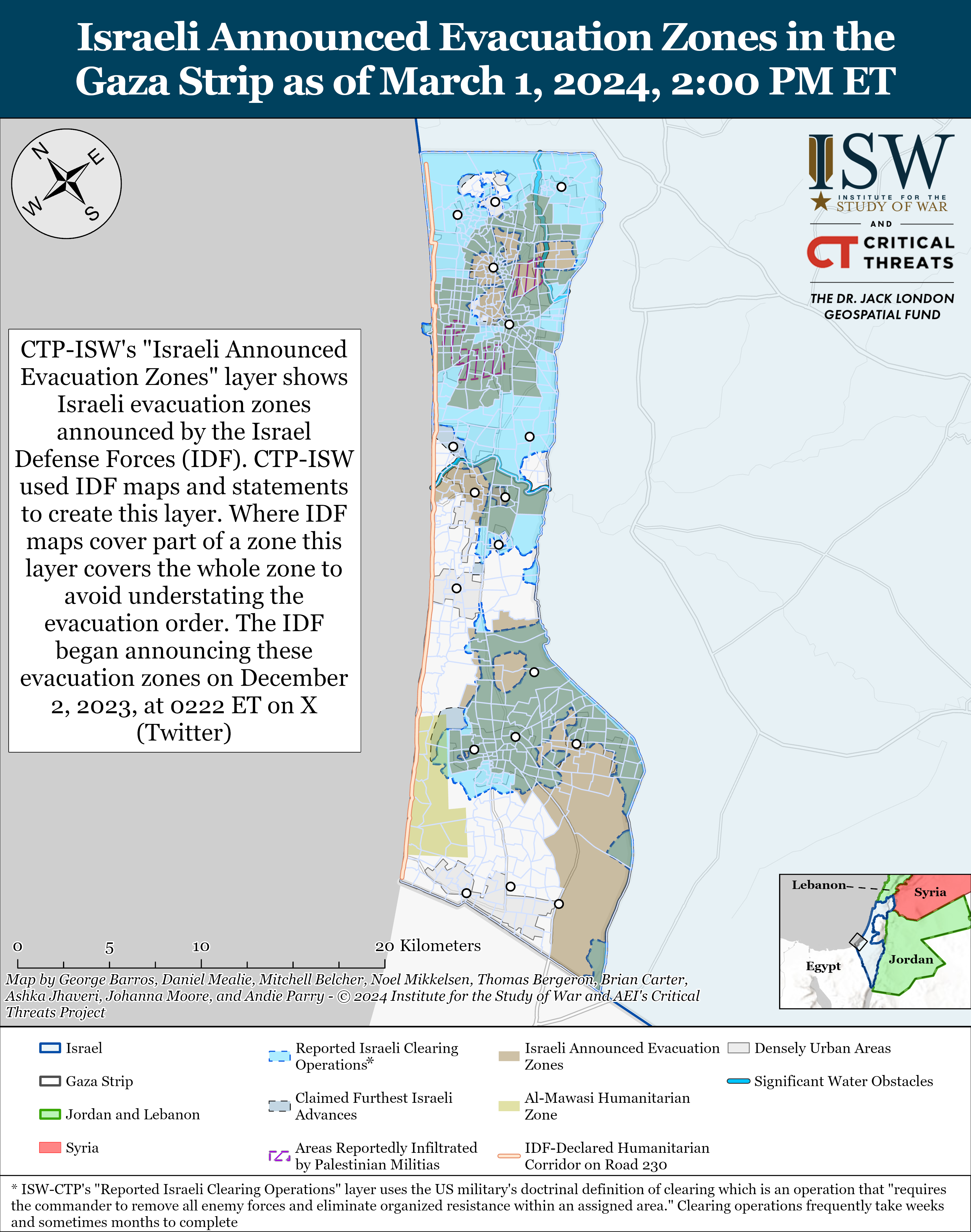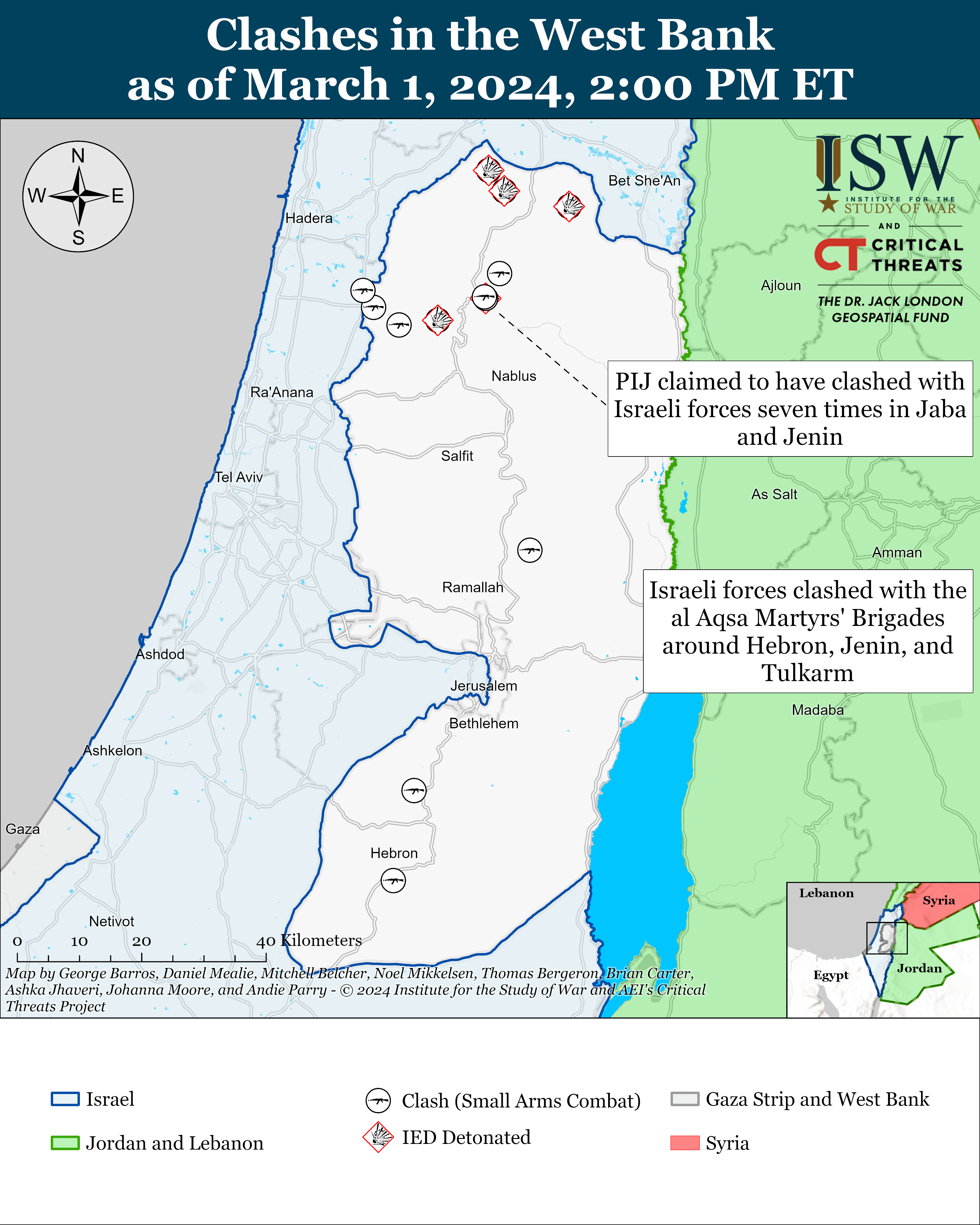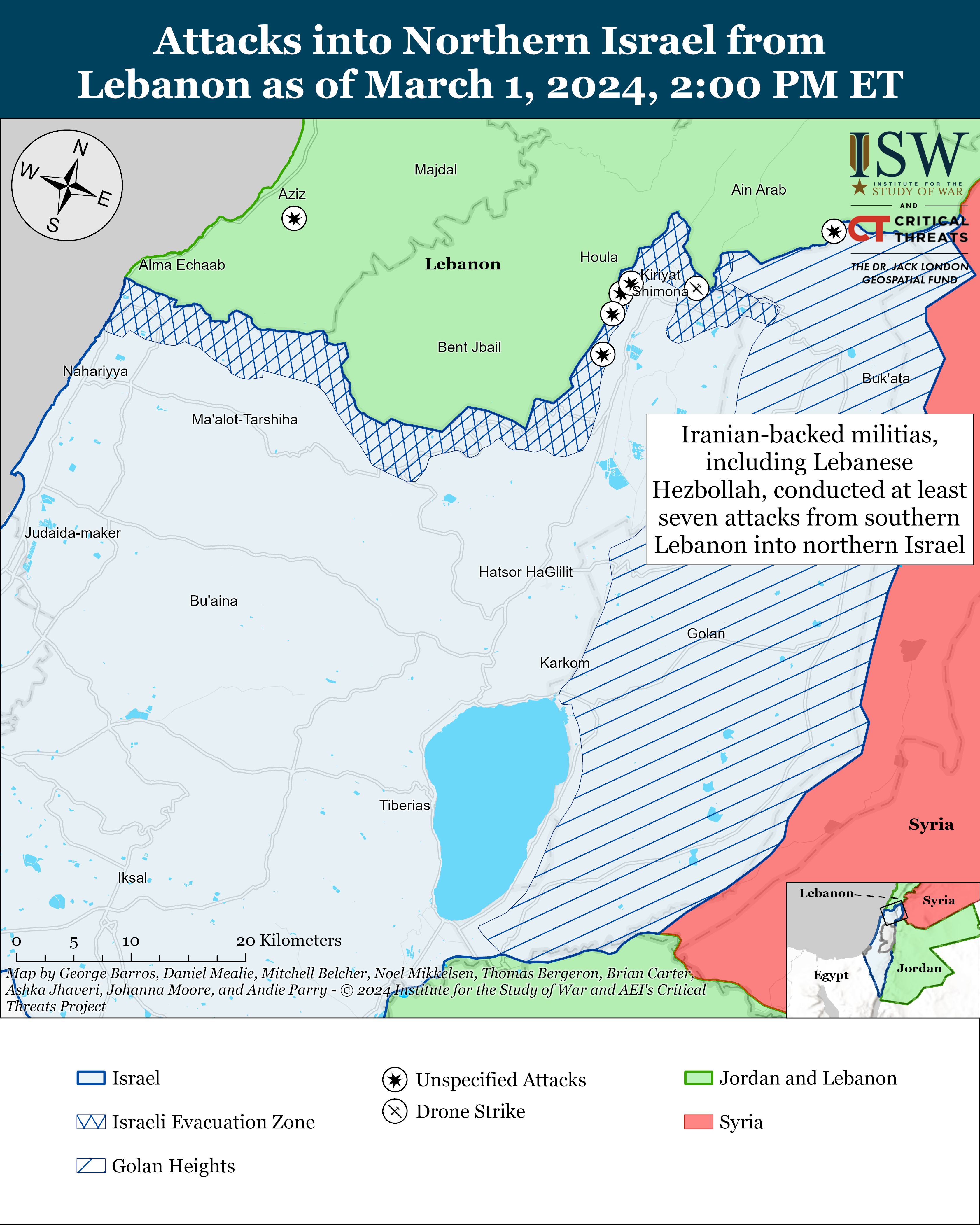Annika Ganzeveld, Ashka Jhaveri, Alexandra Braverman,
Johanna Moore, Tor Lansing, and Nicholas Carl
Information Cutoff: 2:00 pm ET
The Iran Update provides insights into Iranian and Iranian-sponsored activities abroad that undermine regional stability and threaten US forces and interests. It also covers events and trends that affect the stability and decision-making of the Iranian regime. The Critical Threats Project (CTP) at the American Enterprise Institute and the Institute for the Study of War (ISW) provides these updates regularly based on regional events. For more on developments in Iran and the region, see our interactive map of Iran and the Middle East.
Note: CTP and ISW have refocused the update to cover the Israel-Hamas war. The new sections address developments in the Gaza Strip, the West Bank, Lebanon, and Syria, as well as noteworthy activity from Iran’s Axis of Resistance. We do not report in detail on war crimes because these activities are well-covered in Western media and do not directly affect the military operations we are assessing and forecasting. We utterly condemn violations of the laws of armed conflict and the Geneva Conventions and crimes against humanity even though we do not describe them in these reports.
Click here to see CTP and ISW’s interactive map of Israeli ground operations. This map is updated daily alongside the static maps present in this report.
Iran held separate elections for Parliament and the Assembly of Experts on March 1.[1] These elections will likely preserve and possibly even reinforce hardliner influence in the Iranian regime. Parliament is the primary legislative body in the Iranian regime, though it is a relatively weak institution in the Iranian political landscape. One of Parliament’s most important roles is selecting a parliament speaker, who will serve ex officio on more prominent regime policymaking bodies, such as the Supreme National Security Council, Supreme Economic Coordination Council, and Supreme Cultural Revolution Council. Iranian parliamentarians serve four-year teams. Hardline political factions currently dominate Parliament and will likely continue doing so after the votes are counted. The Assembly of Experts is an Iranian regime entity constitutionally responsible for monitoring the supreme leader and selecting his successor.[2] Assembly members serve eight-year terms and are almost exclusively senior Shia clerics.
The Iranian regime is continuing to engineer national elections to consolidate hardline influence in the political establishment. The Guardian Council—a regime body responsible for supervising elections and vetting candidates—barred many moderate and reformist candidates from competing in the March 1 Assembly of Experts and parliamentary elections.[3] The Guardian Council barred former moderate President Hassan Rouhani from running for reelection to the Assembly of Experts, for example.[4] The Guardian Council previously disqualified 80 percent of candidates in the 2016 Assembly of Experts elections and 49 percent of candidates in the 2020 parliamentary elections.[5] The Guardian Council often disqualifies moderate and reformist figures to guarantee hardliner victories in these races. The Guardian Council spokesperson claimed on February 28 that the council had disqualified only 25 percent of parliamentary candidates for the most recent vote, although it is unclear how accurate this number is.[6] Supreme Leader Ali Khamenei personally approves directly or indirectly the members of the 12-person Guardian Council, suggesting that the council operates with the backing of the supreme leader.
Voter turnout appeared to hit a record low, likely reflecting the population’s growing disillusionment with the regime. Initial reports indicate that voter participation was around 27 percent nationally and 12 percent in Tehran on March 1.[7] A voter turnout of approximately 30 percent would mark a record low for public participation in parliamentary elections since the Iranian revolution. Voter participation in parliamentary elections previously reached a record low of 42.5 percent in 2020. Voter participation in the presidential election in 2021 similarly hit a record low of 48.8 percent.[8] These recent numbers are particularly striking given that electoral participation has historically been high in Iran over the past few decades.[9] Regime officials have repeatedly called on the population to participate in the elections, likely reflecting concerns about low voter turnout amid calls for boycotting the elections.[10]
This year’s Assembly of Experts election is uniquely significant, as it could very well oversee the succession of Iran’s next supreme leader. Supreme Leader Ali Khamenei is currently 84 years old and will be 92 by the time of the next Assembly of Experts election in 2032. This cohort of the Assembly of Experts will at least formally choose Khamenei’s successor if he dies or otherwise leaves his post before then.
Key Takeaways:
- Iran: Iran held separate elections for Parliament and the Assembly of Experts. These elections will likely preserve and possibly even reinforce hardliner influence in the Iranian regime. Voter turnout appeared to hit a record low, likely reflecting the population’s growing disillusionment with the regime. This year’s Assembly of Experts election is uniquely significant, as it could very well oversee the succession of Iran’s next supreme leader.
- Northern Gaza Strip: Palestinian militias defended against Israeli operations in the northern Gaza Strip.
- Southern Gaza Strip: Israeli forces continued to conduct clearing operations in western and eastern Khan Younis.
- Political Negotiations: An unspecified senior Israeli official reported that Israel will not continue ceasefire negotiations until Hamas provides information on the status of the hostages it holds in the Gaza Strip.
- West Bank: Israeli forces have clashed with Palestinian fighters in 13 locations across the West Bank.
- Southern Lebanon and Golan Heights: Iranian-backed militias, including Lebanese Hezbollah, have conducted at least seven attacks from southern Lebanon into northern Israel.
- Syria: Israel was likely responsible for an airstrike that killed an Islamic Revolutionary Guards Corps Navy officer in Baniyas, Syria.
- Yemen: US CENTCOM intercepted a drone over the Red Sea and conducted two preemptive strikes targeting six mobile, anti-ship cruise missiles in Houthi-controlled Yemen.
Gaza Strip
Axis of Resistance campaign objectives:
- Erode the will of the Israeli political establishment and public to launch and sustain a major ground operation into the Gaza Strip
- Degrade IDF material and morale around the Gaza Strip.
Palestinian militias defended against Israeli operations in the northern Gaza Strip on March 1. The Israel Defense Forces (IDF) launched a new, “division-wide” clearing operation in the Zaytoun neighborhood in eastern Gaza City on February 20.[11] Palestinian Islamic Jihad (PIJ) published footage on March 1 of its fighters clashing with Israeli forces in Zaytoun.[12] The IDF Nahal Brigade (162nd Division), which has been operating in Zaytoun, killed a Palestinian cell with mortar fire and small arms during clearing operations.[13] The Popular Resistance Committees (PRC), a Palestinian militia aligned with Hamas in the war, reported that it fired rockets targeting Israeli military positions in the northern Gaza Strip. The PRC’s attack was in response to the humanitarian aid convoy incident on February 28.[14]
The al Aqsa Martyrs’ Brigades, which is the self-proclaimed military wing of Fatah and aligned with Hamas in the war, reported that its fighters clashed with Israeli forces east of Jabalia refugee camp.[15] Palestinian Mujahideen Movement fighters similarly fired an unspecified guided munition at an IDF tank east of Jabalia.[16] The Palestinian Mujahideen Movement is a Palestinian faction aligned with Hamas and has expressed close ties with Iran.[17]
PIJ and the al Aqsa Martyrs’ Brigades mortared Israeli personnel near the Erez border crossing with Israel.[18]
Israeli forces continued to conduct clearing operations in western and eastern Khan Younis on March 1. Israeli forces expanded clearing operations to “new areas” east and west of Khan Younis on February 21.[19] The IDF 7th Brigade (36th Division) raided the homes of senior Hamas officials in western Khan Younis and located a weapons depot.[20] The IDF Givati Brigade (162nd Division) has been operating in eastern Khan Younis neighborhoods for the past week, approximately two kilometers from the border with Israel.[21]
Palestinian fighters defended against Israeli operations in several sectors of Khan Younis on March 1. The al Aqsa Martyrs’ Brigades clashed with Israeli forces in al Qarara north of Khan Younis.[22] The militia also reported that its fighters in western Khan Younis fired rocket-propelled grenades (RPG) and mortars targeting Israeli forces.[23]
Hamas leader in the Gaza Strip, Yahya Sinwar, described high casualties among Palestinian civilians as a means to add international pressure on Israel should the IDF proceed with clearing operations in Rafah.[24] Sinwar’s comments reflect Hamas’ tendency to view civilian casualties as a tool to pressure Israel. The Wall Street Journal reported on February 29 that senior Hamas officials in Doha met in early February 2023 amid concerns that Hamas’ military wing in the Gaza Strip was taking heavy losses.[25] Sinwar delivered a message to the leaders claiming that the military wing is doing fine and is ready for an Israeli offensive into Rafah. Sinwar’s comments regarding civilian casualties are reflective of a broader Hamas mindset. A member of Hamas’ Political Bureau indicated two weeks after the October 7, 2023, attacks that the group was prepared to accept heavy losses for the attack—possibly even including high civilian casualties in the Gaza Strip—in support of Hamas’ effort to destroy the Israeli state.[26] There are over a million displaced Palestinian civilians currently in Rafah.[27]
An unspecified senior Israeli official reported that Israel will not continue ceasefire negotiations until Hamas provides information on the status of the hostages it holds in the Gaza Strip.[28] The official said that Qatari and Egyptian mediators failed to provide details from Hamas on the status of hostages.[29] Israel also wants Hamas to offer a ”serious response” on the number of Palestinian prisoners Israel would release under a deal.[30] Israel previously refused to further engage in hostage talks because Hamas demanded that Israel release thousands of Palestinian prisoners as part of the deal.[31] Israel has reportedly agreed since then to a framework that would release up to 400 Palestinian prisoners in exchange for 40 Israeli hostages and a six-week truce.[32] Israel is waiting to see whether the United States’ pressure on mediators and US President Joe Biden’s recent talks with Egyptian and Qatari officials will prompt Hamas to meet Israeli demands.[33]
Hamas claimed on March 1 that seven hostages died due to Israeli airstrikes in the Gaza Strip.[34] Hamas and other Palestinian militias holding hostages in the strip have repeatedly made this claim throughout the war.[35]
Hamas and Fatah agreed to continue meeting with each other after attending talks in Moscow.[36] Several Palestinian factions met in Moscow on February 29 to discuss the formation of a new Palestinian government. Hamas’ political wing published a statement signed by the “Factions that met in Moscow” saying that the talks between several Palestinian factions had been constructive.[37] Fatah emphasized the need for unity among Palestinian factions given the current war in the Gaza Strip after the meeting.[38]
Palestinian militias did not claim any indirect fire attacks from the Gaza Strip into Israel on March 1. The IDF Air Force targeted an area in the northern Gaza Strip from which Palestinian fighters previously fired rockets targeting Israel on February 29.[39] The PRC claimed the rocket attack.[40]
West Bank
Axis of Resistance campaign objectives:
- Draw IDF assets and resources toward the West Bank and fix them there
Israeli forces have clashed with Palestinian fighters in 13 locations across the West Bank since CTP-ISW's last data cutoff on February 29.[41] Local PIJ battalions claimed to have clashed with Israeli forces seven times around Jaba and Jenin.[42] The al Aqsa Martyrs’ Brigades clashed with Israeli forces around Hebron, Jenin, and Tulkarm.[43]
This map is not an exhaustive depiction of clashes and demonstrations in the West Bank.
Southern Lebanon and Golan Heights
Axis of Resistance campaign objectives:
- Draw IDF assets and resources toward northern Israel and fix them there
- Set conditions for successive campaigns into northern Israel
Iranian-backed militias, including Lebanese Hezbollah, have conducted at least seven attacks from southern Lebanon into northern Israel since CTP-ISW's last data cutoff on February 29.[44]
The IDF is continuing to increase its combat readiness around northern Israel. Former IDF spokesperson Avi Benayahu stated that Israeli forces are conducting training meant to simulate combat against Hezbollah around the Israel-Lebanon border.[45]
Recorded reports of attacks; CTP-ISW cannot independently verify impact.
Iran and Axis of Resistance
Axis of Resistance campaign objectives:
- Demonstrate the capability and willingness of Iran and the Axis of Resistance to escalate against the United States and Israel on multiple fronts
- Set conditions to fight a regional war on multiple fronts
Israel was likely responsible for an airstrike that killed an Islamic Revolutionary Guards Corps (IRGC) Navy officer in Baniyas, Syria, on March 1.[46] Syrian media reported that the officer, Colonel Reza Zarei, had connections to Hamas.[47] Syrian media also reported that the airstrike killed three other individuals, two of whom were members of Lebanese Hezbollah.[48] Iranian state media reported that Zarei was assigned to the IRGC’s 1st Naval District, which is responsible for the Strait of Hormuz.[49]
It is unclear what Zarei was doing in Syria, although his deployment to Syria reflects the greater role that the IRGC services other than the Quds Force have assumed in Iran’s regional activities in recent years. The IRGC deployed its regular ground units, for instance, to fight in the Syrian civil war on behalf of Bashar al Assad, as CTP-ISW has assessed extensively.[50] The IRGC Navy and Aerospace Force have similarly increased their operations in Syria in recent years.[51] The Quds Force remains the lead Iranian entity for managing and supporting the so-called “Axis of Resistance” and conducting extraterritorial operations. But the Quds Force also appears to increasingly share part of that mission with other elements of the Iranian security apparatus.[52]
Iranian Foreign Affairs Minister Hossein Amir Abdollahian discussed the Israel-Hamas war during phone calls with his Turkish counterpart and the Qatari prime minister on February 29 and March 1, respectively. Abdollahian emphasized the need for cooperation among Islamic countries to end the war.[53] Abdollahian discussed a potential ceasefire, an exchange of prisoners, and the delivery of humanitarian aid to the Gaza Strip with the Qatari prime minister.[54]
US CENTCOM intercepted a drone over the Red Sea and conducted two preemptive strikes targeting six mobile, anti-ship cruise missiles in Houthi-controlled Yemen on February 29.[55] CENTCOM reported that the drone and cruise missiles presented imminent threats to merchant and US naval vessels in the region.

[1] https://apnews.com/article/iran-parliamentary-election-protests-mahsa-amini-64c628103ff5d193da974c25a13fbb12
[2] https://www.brookings.edu/articles/everything-you-need-to-know-about-irans-assembly-of-experts-election/ ; https://www.mei.edu/publications/moving-post-khamenei-era-role-assembly-experts
[3] https://www.reuters.com/world/middle-east/key-facts-about-irans-elections-friday-2024-02-29/; https://www.washingtoninstitute.org/policy-analysis/five-questions-irans-elections
[4] https://apnews.com/article/iran-former-president-rouhani-disqualified-election-5185fddef7c631d2dfcabc4b361e75e5
[5] https://www.reuters.com/article/idUSKCN0V419V/
[6] https://www.shora-gc dot ir/fa/news/9912/
[7] https://www.theguardian.com/world/2024/mar/01/iran-election-extended-by-two-hours-with-turnout-at-just-27
[8] https://iranprimer.usip.org/blog/2021/jun/23/raisi-election-results-explainer;
https://www.reuters.com/world/middle-east/hardliners-set-tighten-grip-iran-vote-frustration-mounts-2024-03-01/#:~:text=Turnout%20hit%20a%20record%20low,in%20some%20towns%20and%20villages.
[9] https://www.statista.com/statistics/692094/iran-voter-turnout-rate/
[10] https://amwaj.media/media-monitor/calls-for-boycott-rise-as-iran-gears-up-for-election-day
[11] https://twitter.com/GLZRadio/status/1759939842937385257
[12] https://t.me/sarayaps/17517
[13] https://twitter.com/idfonline/status/1763460481388253616; https://twitter.com/idfonline/status/1761643947200237727
[14] https://t.me/alwya2000/6179; https://edition.cnn.com/2024/02/29/middleeast/gaza-food-truck-deaths-israel-wwk-intl/index.html
[15] https://t.me/elaqsa_1965/5895
[16] https://t.me/darebmojahden/4498
[17] https://ecfr.eu/special/mapping_palestinian_politics/mujahideen-brigades/; https://www.newsweek.com/not-only-hamas-eight-factions-war-israel-gaza-184129
[18] https://t.me/sarayaps/17515; https://t.me/nedalps/4011
[19] https://twitter.com/idfonline/status/1760193066785255867
[20] https://www.idf dot il/183489; https://twitter.com/idfonline/status/1763460476824932627
[21] ttps://www.idf dot il/183589
[22] https://t.me/elaqsa_1965/5892
[23] https://t.me/AymanGouda/6075; https://t.me/AymanGouda/6076
[24] https://www.wsj.com/world/middle-east/hamas-thinks-it-could-win-gaza-war-with-israel-6254a8c6
[25] https://www.wsj.com/world/middle-east/hamas-thinks-it-could-win-gaza-war-with-israel-6254a8c6
[26] https://www.washingtonpost.com/national-security/2023/11/12/hamas-planning-terror-gaza-israel/
[27] https://www.theguardian.com/world/2024/feb/26/un-rafah-attack-nail-coffin-gaza-aid-deliveries-halve
[28] https://twitter.com/barakravid/status/1763604195892994350?s=46&t=EGYcIyXosW6lVJmixq2r5Q
[29] https://twitter.com/BarakRavid/status/1763604870337065147
[30] https://twitter.com/BarakRavid/status/1763604195892994350
[31] https://www.axios.com/2024/02/14/gaza-hostage-talks-netanyahu-egypt-qatar
[32] https://abcnews.go.com/International/live-updates/israel-gaza-hamas-war/israel-agrees-to-updated-framework-in-ceasefire-hostage-deal-107520344?id=107535302%C2%A0;%C2%A0https://www.timesofisrael%C2%A0dot
[33] https://twitter.com/BarakRavid/status/1763605511801352677
[34] https://t.me/qassam1brigades/1705
[35] https://t.me/qassam1brigades/1343
[36] https://www.cnn.com/middleeast/live-news/israel-hamas-war-gaza-news-03-01-24/h_e98b25b0a4d79bba53de4b5e86cf6a17
[37] https://t.me/hamasps/19661; https://www.cnn.com/middleeast/live-news/israel-hamas-war-gaza-news-03-01-24/h_e98b25b0a4d79bba53de4b5e86cf6a17
[38] https://www.cnn.com/middleeast/live-news/israel-hamas-war-gaza-news-03-01-24/h_e98b25b0a4d79bba53de4b5e86cf6a17
[39] https://twitter.com/idfonline/status/1763460479945527410
[40] https://t.me/alwya2000/6178
[41] https://t.me/sarayajneen/1202; https://t.me/sarayajneen/1201; https://t.me/elaqsa_1965/5894; https://t.me/elaqsa_1965/5887;
https://t.me/elaqsa_1965/5888; https://t.me/elaqsa_1965/5889
[42] https://t.me/sarayajneen/1201; https://t.me/sarayajneen/1202
[43]
https://t.me/elaqsa_1965/5890; https://t.me/elaqsa_1965/5894; https://t.me/elaqsa_1965/5887
[44] https://twitter.com/idfonline/status/1763557384100737288 ; https://t.me/mmirleb/2347 ; https://t.me/mmirleb/2349 ; https://t.me/mmirleb/2352 ; https://t.me/mmirleb/2355 ; https://t.me/mmirleb/2357
[45] https://www.maariv dot co.il/journalists/Article-1080238
[46] https://www.tasnimnews dot com/fa/news/1402/12/11/3047940/ ; https://twitter.com/GLZRadio/status/1763545234586128626;
https://www.irna dot ir/news/85404199/سومین-مدافع-حرم-از-هرمزگان-به-خیل-شهدا-پیوست-فیلم
[47] https://t.me/damascusv011/21167
[48] https://t.me/damascusv011/21167
[49] https://www.dia.mil/Portals/110/Images/News/Military_Powers_Publications/Iran_Military_Power_LR.pdf ; https://www.mehrnews dot com/news/6042776 ; https://www.tasnimnews dot com/fa/news/1402/12/11/3047940/
[50] https://www.aei.org/foreign-and-defense-policy/middle-east/irans-evolving-way-of-war-how-the-irgc-fights-in-syria/ ; https://www.criticalthreats.org/analysis/irans-reserve-of-last-resort-uncovering-the-islamic-revolutionary-guard-corps-ground-forces-order-of-battle
[51] https://www.aei.org/foreign-and-defense-policy/middle-east/irans-evolving-way-of-war-how-the-irgc-fights-in-syria/ ; https://www.criticalthreats.org/analysis/iran-update-april-11-2023
[52] https://www.aei.org/research-products/report/pivot-to-offense-how-iran-is-adapting-for-modern-conflict-and-warfare/
[53] https://mfa dot ir/portal/newsview/740712 ; https://en.mehrnews dot com/news/212471
[54] https://mfa dot ir/portal/newsview/740711
[55] https://www.centcom.mil/MEDIA/PRESS-RELEASES/Press-Release-View/Article/3691742/feb-29-red-sea-update/

